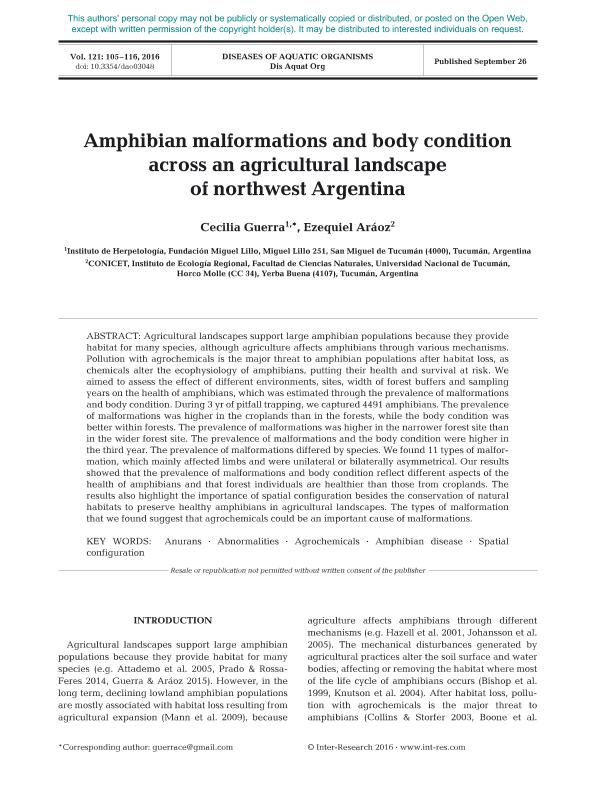Mostrar el registro sencillo del ítem
dc.contributor.author
Guerra, Cecilia

dc.contributor.author
Aráoz, Ezequiel

dc.date.available
2018-08-16T12:54:29Z
dc.date.issued
2016-09
dc.identifier.citation
Guerra, Cecilia; Aráoz, Ezequiel; Amphibian malformations and body condition across an agricultural landscape of northwest Argentina; Inter-Research; Diseases Of Aquatic Organisms; 121; 2; 9-2016; 105-116
dc.identifier.issn
0177-5103
dc.identifier.uri
http://hdl.handle.net/11336/55831
dc.description.abstract
Agricultural landscapes support large amphibian populations because they provide habitat for many species, although agriculture affects amphibians through various mechanisms. Pollution with agrochemicals is the major threat to amphibian populations after habitat loss, as chemicals alter the ecophysiology of amphibians, putting their health and survival at risk. We aimed to assess the effect of different environments, sites, width of forest buffers and sampling years on the health of amphibians, which was estimated through the prevalence of malformations and body condition. During 3 yr of pitfall trapping, we captured 4491 amphibians. The prevalence of malformations was higher in the croplands than in the forests, while the body condition was better within forests. The prevalence of malformations was higher in the narrower forest site than in the wider forest site. The prevalence of malformations and the body condition were higher in the third year. The prevalence of malformations differed by species. We found 11 types of malformation, which mainly affected limbs and were unilateral or bilaterally asymmetrical. Our results showed that the prevalence of malformations and body condition reflect different aspects of the health of amphibians and that forest individuals are healthier than those from croplands. The results also highlight the importance of spatial configuration besides the conservation of natural habitats to preserve healthy amphibians in agricultural landscapes. The types of malformation that we found suggest that agrochemicals could be an important cause of malformations.
dc.format
application/pdf
dc.language.iso
eng
dc.publisher
Inter-Research

dc.rights
info:eu-repo/semantics/embargoedAccess
dc.rights.uri
https://creativecommons.org/licenses/by-nc-sa/2.5/ar/
dc.subject
Abnormalities
dc.subject
Agrochemicals
dc.subject
Amphibian Disease
dc.subject
Anurans
dc.subject
Spatial Configuration
dc.subject.classification
Ciencias Medioambientales

dc.subject.classification
Ciencias de la Tierra y relacionadas con el Medio Ambiente

dc.subject.classification
CIENCIAS NATURALES Y EXACTAS

dc.title
Amphibian malformations and body condition across an agricultural landscape of northwest Argentina
dc.type
info:eu-repo/semantics/article
dc.type
info:ar-repo/semantics/artículo
dc.type
info:eu-repo/semantics/publishedVersion
dc.date.updated
2018-08-15T14:21:40Z
dc.journal.volume
121
dc.journal.number
2
dc.journal.pagination
105-116
dc.journal.pais
Alemania

dc.description.fil
Fil: Guerra, Cecilia. Fundación Miguel Lillo. Dirección de Zoología. Instituto de Herpetología; Argentina. Consejo Nacional de Investigaciones Científicas y Técnicas; Argentina
dc.description.fil
Fil: Aráoz, Ezequiel. Universidad Nacional de Tucumán. Instituto de Ecología Regional. Consejo Nacional de Investigaciones Científicas y Técnicas. Centro Científico Tecnológico Conicet - Tucumán. Instituto de Ecología Regional; Argentina. Consejo Nacional de Investigaciones Científicas y Técnicas; Argentina
dc.journal.title
Diseases Of Aquatic Organisms

dc.rights.embargoDate
2021-10-01
dc.relation.alternativeid
info:eu-repo/semantics/altIdentifier/doi/http://dx.doi.org/10.3354/dao03048
dc.relation.alternativeid
info:eu-repo/semantics/altIdentifier/url/https://www.int-res.com/abstracts/dao/v121/n2/p105-116/
Archivos asociados
